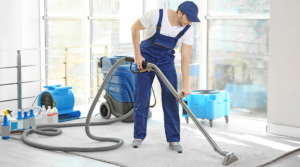After you read these steps and cleaning tips, you won’t have to worry about food traffic, pet stains, drink spills, or anything else. And you won’t have to do a spot clean now and then. Let me tell you exactly how to clean an area rug.
1. Take Your Cleaning Tools Outdoors
I tend to quick-fix my rugs’ cleaning process until it’s summer. The best way to clean your rug is to take it outside! I rely on my weather app to check the week’s forecast, and when it’s predicted to be sunny, I start preparing for my area rug cleaning day.
I’ve tried using clotheslines for this, but it didn’t work. Instead, I found thick ropes to be the solution, and since I had a couple of trees around, I stretched the rope between them. Also, walls and benches can work perfectly fine; you just need something to handle the rug’s weight.
Moreover, you’ll need a carpet shampoo or mild dish soap, a bucket, a soft-bristled brush or sponge, a garden hose, and a vacuum. If your hands are sensitive, you may need rubber gloves as well.
2. Thoroughly Vacuum Your Rug
Using your vacuum cleaner, start vacuuming both sides of the rug to remove dirt, dust, stray hairs, or anything else that’s lingering on it. You can also sprinkle some baking soda before vacuuming to neutralize odors.
Once you’re done, roll up your area rug and take it outdoors to where your cleaning tools are. Now, carefully unroll it and make sure you keep the right side facing you.
I always give my rug a beat with a rug beater to double-check that there’s no dirt remaining. Most of the time, I’m faced with clouds of dust, so I repeat this step several times.
3. Test Your Rug Shampoo
The most common cleaning solution for rugs is rug shampoo. Regardless of which you choose, make sure to follow its cleaning instructions. If you don’t have one, you can use a mild dish detergent mixed with warm water. And if you have a wool rug, mix laundry detergent with cold water.
Always test your shampoo before you use it on the whole area rug. I had to learn that the hard way when one of my favorite rugs got color-damaged while cleaning it. So, first, apply a little amount to a corner of the rug, add some water, and let it sink in for a couple of hours.
After that, rinse that spot and see if there’s any damage. I also want to note that I know we tend to “DIY” our rug cleaners, but it’s best to get one specifically made for rugs. There are different shampoos for different materials, so make sure you align them together.
4. Wash Your Rug and Apply the Shampoo
Now that you’ve tested your shampoo, go ahead and rinse the rug. I usually use a garden hose to make sure that every part of the rug is wet and equipped for the full shampoo application.
I use a brush with a sturdy handle to push the shampoo far into the carpet’s fibers, giving it a deep clean with a lot of lather. Also, make sure you give double the attention to all the stains.
However, for wool area rugs, use a damp microfiber cloth with soapy water and gently tap on the surface as much as needed.
5. Rinse the Rug
Follow the care instructions written on your rug shampoo and leave it for as long as stated. Generally, you shouldn’t rinse it before at least 5 minutes. After that, use your garden hose to rinse the shampoo out. Be very rigorous with this, as you don’t want any residue on your rug.
6. Remove Excess Water and Dry the Rug
It sounds simple, but drying the rug isn’t exactly easy. You’re going to have to wring the rug several times to dispose of the excess water. A squeegee comes in handy at this stage.
Even after that, you’ll still find the rug very wet. You’ll have to let the rug dry completely by leaving it in a laundry room, garage, or large balcony for protected drying. Be patient, though, as the drying process can take some time depending on its heaviness and the weather.
Also, don’t forget the bottom side of the rug! When the top has dried completely, flip it over and leave the bottom side of the rug to dry as well. After it’s fully dry, try to squeeze it. If it’s stiff, you’re good to go! You shouldn’t feel a single drop of water.
7. One Last Vacuuming
When you put the area rug back into the living room or any other room, it’s best to vacuum it one more time. Cleaning products and water tend to give rugs a different appearance after they’re washed since the fibers are squished. By vacuuming your rug, you’re restoring it and combing its fibers.
Final Thoughts
Clean rugs are just heaven! They’re always the missing puzzle piece that complements the room they’re placed in. However, when they’re not entirely clean, they can pull down their surroundings as well.
Now that you know the ins and outs of how to clean large area rugs, you won’t have to hire carpet cleaner experts anymore or get frustrated every time you look at your area rug!
However, just a little disclaimer: these steps are for cleaning synthetic fiber area rugs, not all rugs. If your rug is small, you can follow the same steps. It’ll be even easier to take outside and shake.
Yet, if you own delicate rugs, like a shag rug, oriental rugs, Persian rugs, or antique rugs, certainly don’t DIY.
Needless to say, cotton rugs made of natural fiber are the best; they’re so simple to clean since they’re just inserted into a washing machine set on the delicate mode and mixed with laundry detergent and cold water!
Credits to Kimberly Smith






